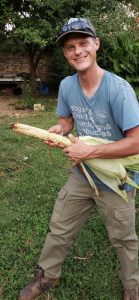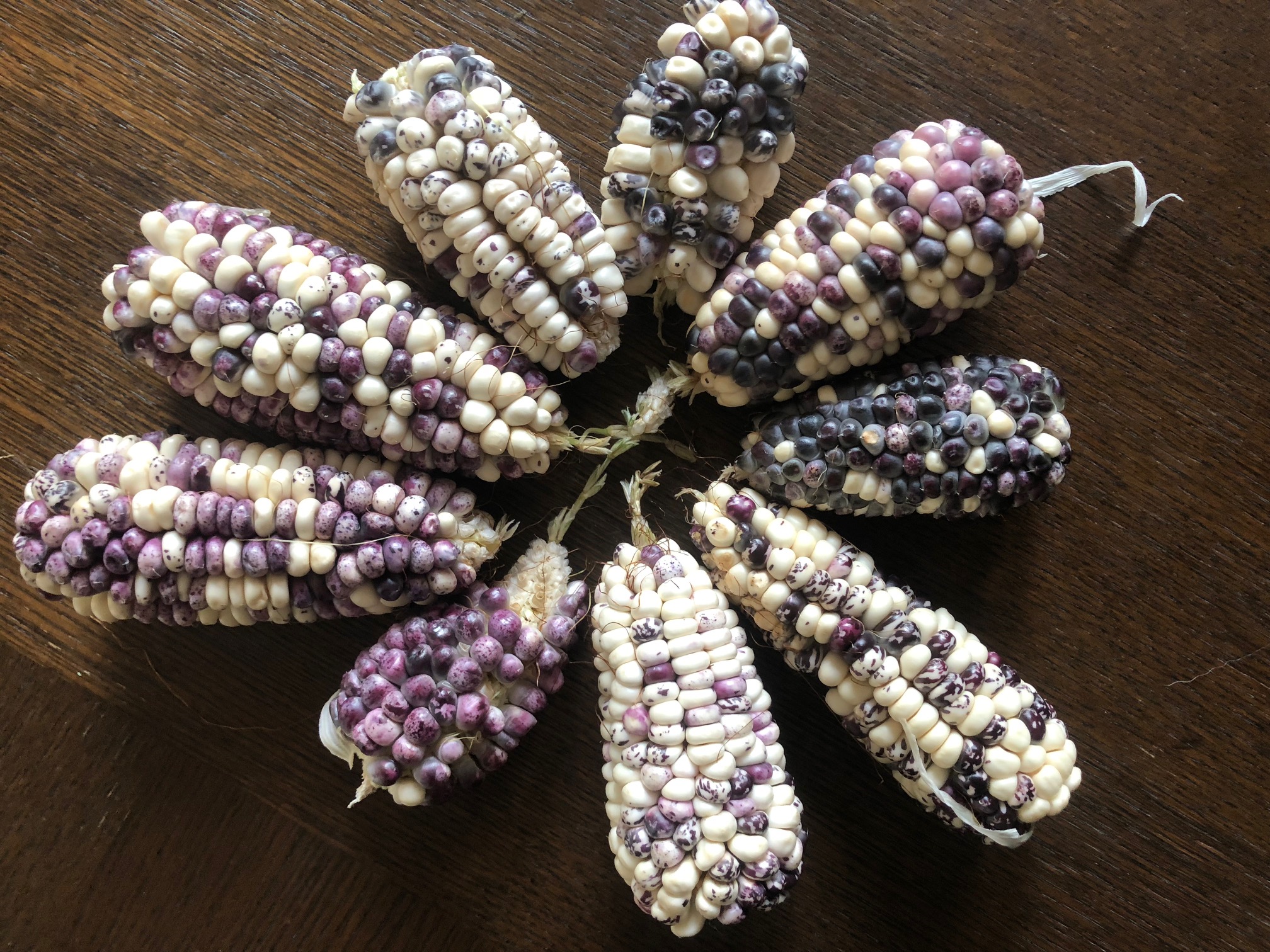
Mike Fortune and Jala corn from Mexico
Mike Fortune has an ambitious goal: to dramatically reduce the need for synthetic nitrogen in agriculture, whose overuse is wreaking environmental havoc in the world. Fortune, an organic farmer in Asheville, North Carolina, is breeding unique ancient corn varieties from South America that produce their own nitrogen, aiming to grow them on millions of acres in the U.S., thus saving the environment from the damage of excess nitrogen.
World must cut nitrogen use by 50%
Synthetic nitrogen fertilizers have helped increased crop yields but excess amounts, particularly from corn production, are running off of farms, polluting waterways, and killing marine life, creating a “dead zone” the size of New Jersey in the Gulf of Mexico. The International Nitrogen Management System has warned that the world must cut its use of synthetic nitrogen in half by 2050 or our ecosystems will face epidemics of toxic tides, lifeless rivers, and dead oceans. Not a pretty picture.
Sounds like a monumental problem but Mike Fortune thinks he has a solution in ancient corn varieties grown in Peru. Fortune, owner of Green Hill Urban Farm, traveled to Peru in 2013 and became fascinated by the country’s diverse corn varieties such as purple Maiz Morado, which contains antioxidant-producing anthocyanins, speckled Piscorunto, and Cuzco Gigante, named for its large two-foot-long ears and 25-foot stalks. Like Mexico, Peru is a center for corn genetic diversity with some 55 different varieties.
“I fell in love with the diversity of corn in Peru,” Fortune says.
Fortune obtained seeds for five Peruvian varieties and started growing them in 2014, successfully growing two varieties, Maiz Morado and Piscorunto. It turns out that Asheville’s location at around 2,100 feet in the Blue Ridge Mountains is ideal for growing those varieties, which grow in Peru’s high altitudes. Fortune grows vegetables at elevations ranging from 2,200 to 3,000 feet in the Asheville area.
“Asheville is the perfect altitude and latitude to grow these corns,” he says.
The problem is that while many North American corn varieties take about 100 days to mature, Peruvian varieties take more than 200 days.
“They are hard to grow in the U.S.,” Fortune says. “It takes the right amount of daylight hours to make ears and they don’t produce ears until very late in the season.”
In most corn-growing regions of the U.S., that would be too late in the season; cold weather would prevent the ears from maturing.
Discovery of nitrogen-producing ability
Fortune had heard that some of Peru’s corns produced their own nitrogen, and he discovered this when he started growing them. The corns secrete a mucus-like gel out of aerial roots, which grow above ground, along its stalk. This gel contains bacteria that convert atmospheric nitrogen into a form usable by the plants.
Fortune read about a study by researchers that confirmed some corns’ ability to produce their own nitrogen. Researchers at the University of Wisconsin–Madison, the University of California, Davis, and Mars, Inc., identified varieties of tropical corn from Oaxaca, Mexico that can acquire a significant amount of the nitrogen they need by producing the gel containing bacteria. The study found that the corns can acquire 30% to 80% of their nitrogen in this way depending on weather conditions.
Fortune contacted co-author of the study, Jean-Michel Ané, a professor of bacteriology and agronomy at the University of Wisconsin, who told him that the Mexican corn variety he studied was Sierra Mixe.
Speaking of the research with Sierra Mixe, Ané says “This corn showed us that nature can find solutions to some problems far beyond what scientists could ever imagine.”
He also says it has been a long-term dream to transfer the ability to associate with nitrogen-fixing bacteria from legumes to cereals.
Fortune has called creating a corn that can feed itself “the Holy Grail of sustainable agriculture.”
Breeding efforts
Using traditional plant-breeding techniques, Fortune has bred Maiz Morado, Piscorunto, and other heirloom corn varieties for the past seven years, adapting them to the North American environment and hybridizing them with other corn varieties, with the goal of developing a nitrogen-producing corn that can be grown by U.S. farmers.
In 2018, Stephen Smith, seed collection manager at the Roughwood Seed Collection, visited Fortune’s farm because few people had ever successfully grown Piscorunto in North America. This past spring Smith sent Fortune eight more corn varieties to breed.
In June, Fortune connected with a seed collector in Indiana on Facebook who sent him seeds for Potawatomi Mskigwat, a deep red heirloom corn variety of the Potawatomi tribe based in Oklahoma. Potawatomi produces a small amount of the aerial roots with the nitrogen producing gel.
“It is the only variety in the continental U.S. I’ve heard of that does it,” he says.
Fortune crossed Potawatomi with Maiz Morado and Jala, a Mexican variety that produces ears up to three feet long.
As a result of his breeding efforts, Fortune says he now has 50-100 different corn varieties.
“Every time I grow them out, there are new corns that have never been seen before in the world,” he says.
Some biotechnology companies such as IntrinsyxBio and Pivot Bio are working with microorganisms like bacteria to help plants supply their own nitrogen using seed treatments or direct applications.
Fortune emphasizes his production is non-GMO. “I am opposed to GMOs and feel having these seeds created in a more open-pollinated style will allow future growers to save and adapt these seeds to their own locale, which is of upmost importance.”
Grow nitrogen-producing corns on millions of acres
This year, Fortune plans to breed his Peruvian varieties with North American “dent” corns such as Bloody Butcher, Kentucky Butcher, and Cherokee White Eagle. He is working with a farm in Illinois to test the varieties in Midwest cornbelt conditions.
He admits this process will take time but he is confident.
“It will normally take about 7 generations to stabilize a new corn variety,” he says. “Through trialing and selection in the coming generations, I believe it is only a matter of time until I can stabilize not just interesting new corns, but several that could provide an environmentally beneficial contribution to our modern corn production model.”
Fortune says he wants to change the world. “I want to produce a better corn that could potentially be scaled up to millions of acres that could reduce nitrogen need by 20% to 60%. That could make a huge difference in our lakes and rivers and the Gulf of Mexico.”









